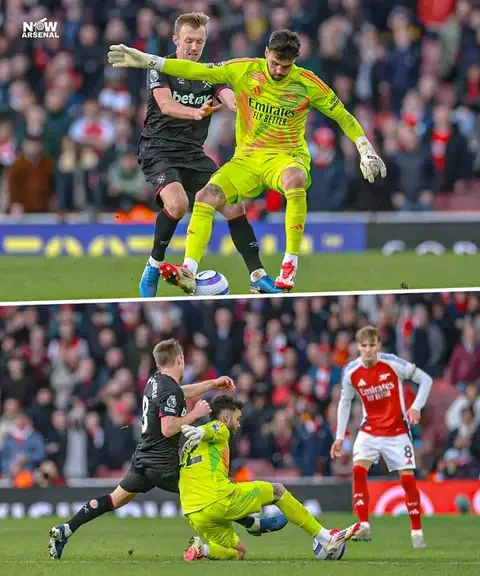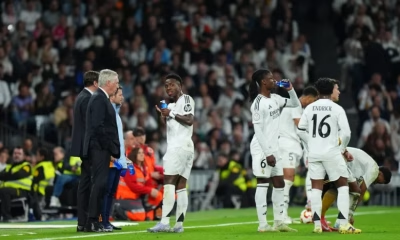Arsenal
⚽⚽You know it’s a bad game when the highlight of the match is David Raya winning a foot race, doing a Cruyff turn on the halfway line and then finding the pass to Martin Ødegaard

This statement humorously highlights how dull or uneventful a particular football match was by pointing out an unusual moment as its “highlight.” To break it down in great detail, let’s analyze each part of the sentence, the context, and the footballing implications behind it.
—
1. “You know it’s a bad game when…”
This phrase sets the tone, suggesting that the match in question was far from exciting. In football, a “bad game” typically means:
Lack of goals – If a match ends in a goalless draw (0-0) or has very few shots on target, fans often describe it as dull.
Lack of attacking play – A match where both teams play defensively, passing sideways or backward instead of creating goal-scoring opportunities, is often labeled boring.
Slow pace – If players aren’t pressing aggressively or the game lacks intensity, it can feel uneventful.
Mistakes over moments of brilliance – When the only notable events are errors (misplaced passes, poor touches, fouls, etc.), it detracts from the quality of the game.
Lack of entertainment value – Football fans watch for excitement—whether it’s skillful dribbles, long-range strikes, counterattacks, or moments of individual brilliance. If none of these happen, fans can lose interest quickly.
By starting the sentence with “You know it’s a bad game when…,” the speaker is implying that the usual excitement was absent, making an odd event the standout moment.
—
2. “The highlight of the match is David Raya winning a foot race…”
Who is David Raya?
David Raya is a Spanish goalkeeper who plays for Arsenal. Typically, goalkeepers are not involved in attacking play, and their primary job is to stop the opposition from scoring. However, in modern football—especially in teams managed by coaches like Mikel Arteta or Pep Guardiola—goalkeepers are expected to play with their feet, almost like an extra outfield player.
Why is this significant?
For a goalkeeper to be involved in a foot race is highly unusual. Goalkeepers rarely leave their penalty area, let alone race up the pitch to win a ball. This suggests:
The opposing team likely played a long ball or a counterattack attempt, forcing Raya to leave his goal and act as a “sweeper keeper.”
Arsenal’s defensive line was playing high up the pitch, which required the goalkeeper to cover more ground.
The game lacked excitement from strikers, wingers, or midfielders, meaning a goalkeeper running became a moment worth noting.
In an ideal match, the highlights should include goals, dribbles, assists, and brilliant saves, not a goalkeeper winning a sprint against an opponent. The fact that this moment stood out suggests that the rest of the match was forgettable.
—
3. “…doing a Cruyff turn on the halfway line…”
What is a Cruyff Turn?
A Cruyff turn is a famous dribbling move named after Dutch legend Johan Cruyff. It involves a player pretending to pass or shoot but then using their inside foot to drag the ball behind their standing leg, spinning in the opposite direction to fool a defender.
This is a highly technical skill move usually performed by:
Creative midfielders (No. 10s like Martin Ødegaard or Kevin De Bruyne)
Wingers who want to deceive their marker
Skillful strikers looking to create space
For a goalkeeper to attempt this move is extremely rare and risky. If he loses possession, the opponent could have an open goal to score in. Raya performing a Cruyff turn suggests:
He was under pressure but had the confidence (or necessity) to evade an opponent with skill.
The opponent failed to anticipate a goalkeeper trying such a move, which speaks volumes about the match’s tempo.
The game was so devoid of action that fans found this moment more entertaining than anything else.
Again, in a high-quality match, a goal, a last-minute save, or an incredible pass would be the highlight—not a goalkeeper doing a turn in midfield.
—
4. “…and then finding the pass to Martin Ødegaard.”
Martin Ødegaard is Arsenal’s captain and playmaker, responsible for controlling the game and creating chances. Normally, Ødegaard should be receiving passes from midfielders or defenders—not from the goalkeeper in an advanced position.
This tells us:
Raya was positioned so high up the pitch that he was able to act like a midfielder, delivering passes directly to his teammates.
The game might have been so one-sided (Arsenal dominating possession) that Raya felt comfortable pushing far up.
There was a lack of creativity elsewhere, making his pass seem like a “highlight.”
A match where the biggest moment is a goalkeeper passing to a midfielder instead of a striker scoring a brilliant goal means the overall entertainment value was quite low.
—
Conclusion: Why This is a Funny but Critical Statement
The humor in this sentence lies in the contrast between what should be a match highlight and what actually was. In an exciting game, people remember:
✅ Stunning goals
✅ Dramatic late winners
✅ Jaw-dropping saves
✅ Tactical battles
✅ Beautiful assists
Instead, this match is being remembered for:
❌ A goalkeeper sprinting
❌ A goalkeeper doing a skill move
❌ A goalkeeper passing like a midfielder
It suggests that either:
The attacking players underperformed.
The game lacked intensity and excitement.
Arsenal was so dominant that their goalkeeper had time to play like an outfielder.
Ultimately, football is meant to be exciting, and this sarcastic remark highlights how dull this particular match was.
-

 Manchester United7 months ago
Manchester United7 months agoManchester United fired off more than 22 attempts trying to find the net against Nottingham Forest, with one player squandering around six clear opportunities without scoring. Ruben Amorim was visibly frustrated, publicly calling out a Manchester United star for failing to convert even once, despite facing an unguarded goal on multiple occasions.
-

 Manchester United7 months ago
Manchester United7 months agoBREAKING NEWS: “Isak Has Agreed to Join Man United… BUT Only If They Allow That Guy to Join Us!” – Eddie Howe’s Shocking Transfer Demand Stuns Fans.
-

 Liverpool7 months ago
Liverpool7 months agoLFC TRANSFER UPDATES LIVE Liverpool open to selling ( 7) players this summer, including £50 million star who Arne Slot claimed is ‘important’
-

 Liverpool7 months ago
Liverpool7 months agoReal Madrid are discussing a move to appoint former Liverpool boss Jürgen Klopp as their new manager if Carlo Ancelotti steps away and takes over Brazil.
-

 Real Madrid7 months ago
Real Madrid7 months agoI have warned Carlo Ancelotti about that particular player, he refused to bench him, He keeps causing problems to the teams, He Almost Denied Real Madrid three points against Real Sociedad after taking the lead in the Copa del Rey Semi Finals “: Former Real Madrid Legend Cristiano Ronaldo names ONE player who doesn’t deserve to start for Real Madrid, warned Ancelotti about the unforgivable mistake
-

 Premier League7 months ago
Premier League7 months agoPremier League Shock: Manager Sacked Amid Season Struggles”
-

 Liverpool7 months ago
Liverpool7 months agoAlexander Isak to Liverpool swap deal option emerges as transfer pathway clears
-

 Barcelona6 months ago
Barcelona6 months agoFIFA officially announces Barcelona will play in the FINAL—and Inter Milan have been KICKED OUT… after referee Szymon Marciniak was ARRESTED in a stunning late-night operation!…
